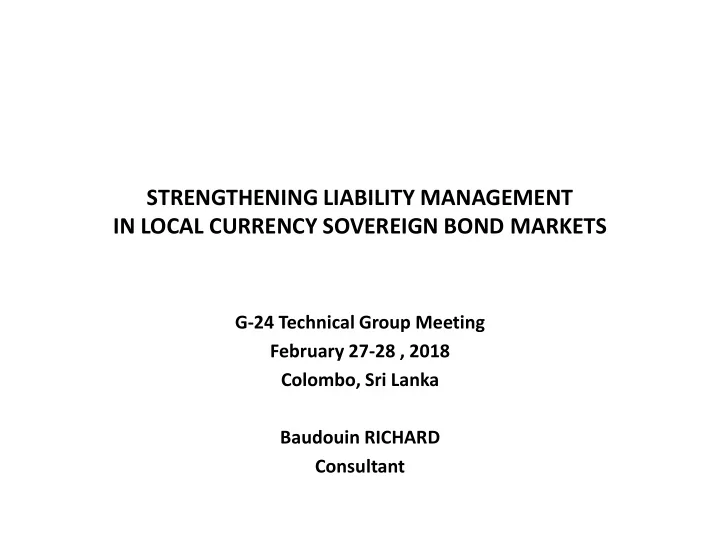

STRENGTHENING LIABILITY MANAGEMENT IN LOCAL CURRENCY SOVEREIGN BOND MARKETS G-24 Technical Group Meeting February 27-28 , 2018 Colombo, Sri Lanka Baudouin RICHARD Consultant
PLAN 1. Specificity of Liability Management (LM) vs. Public Debt Management (PDM) 2. Rationale of liability management operations ( LMO) in local currency bond market ( LCBM) 3, Historical evolution 4. Strengthening LM in markets at their initial stage of development 2
I. SPECIFICITY OF LIABILITY MANAGEMENT (LM) vs. PUBLIC DEBT MANAGEMENT (PDM) PDM : its function is to provide financing to the government. This implies incurring new liabiliies . Its objective is to minimize cost and/ or risks LM : its objective is also to minimize cost and/ or risks but Its function is to restructure oustanding borrowings to improve the composition of the existing debt portfolio. Therefore, LM provides no additional funding . A a result, the scope of the risks covered is narrover in LM than in PDM Eg. LM is normally not involved in the management of legal risks, operational risks ,credit risk, contingency risks, etc. unless the hedge can also restructure an already outstanding debt. 3
II. RATIONALE OF LIABILITY MANAGEMENT OPERATIONS ( LMO) IN LOCAL CURRENCY BOND MARKET ( LCBM) The main rationale of LM is to support market development . It does so by . decreasing refinancing risk . deinforcing the creation of benchmarks . increasing price transparency The instruments used most often in the LCBM are bond buy back (BB) and bond exchanges (BX) . Derivatives are less used than in the international markets As the LCBM market develops . the focus of LMO increasingly shifts to enhancing markt miquidity . the volume and scope of LM widens ( with the exception of markets that are intrinsically liquid (eg. US, Germany; Switzer land) 4
III. HISTORICAL EVOLUTION LMOs in LCBM have evolved in three stages as their objective widens . Step 1 : to decrease the refinaning risk (RR) created by large maturities a. Buy Back of short maturities Advantages lower RR ( prefunding) lower interest rate risk ( smoothened maturity profile) creation of a borrowing need which accelerates the issuance of new benchmarks b. Bond exchanges : a bond with a short remaing life to maturity is retired from the market with the issuance of a longer maturity bond. decreased market risk (the two transactions are simultaneous) further increases price transparency facilitates lengthening of the average life of the debt portfolio . 5
HISTORICAL EVOLUTION Step 2: Increase the liquidity of the debt portfolio Exchange of two bonds both with long maturiities Initially switches to retire an illliquid bond Thereafter also . switches between illiquid bonds to facilitate market making (Canada) . systematic exchange offer of previous benchark against new (Turkey) . offer market makers a selling opportunity to lighten unwanted positions (Denmark ) . . 6
HISTORICAL EVOLUTION Step 3 ( not necessarily after step 1&2): Other &&objectives Eg.: . to correct market distortions ( Italy arbitrages) . to support the good functioning of the market ( Brazil simultaneous buy/sell auctions) . to restore issuer’s access to the market ( Ireland in 1992) . to create a borrowing need to be able to keep issuing ( Denmark in mid nineties) 7
IV. STRENGTHENING LM IN DEVELOPING MARKETS In view of the multiple and significatic advantages of LM, one may wonder why LM is not used earlier in some developing markets The reason is that LM operations confront developing markets with three challenges, particularly at their initial stage of development . Selecting the instrumen t which is most appropriate to them . Selecting the procedur e for using the selected instrument . Convincing investors and issuer that they have a common vested interest in cooperating to put the selected procedure in place 8
DEVELOPING MARKETS CONFRONTED CHALLENGES 1, Selecting the instrument . Standing liquidity cushion . Ad hoc liquidity cushion ( cash management) . Committed line of credit . Bond buy back (BB) . Bond exchange (BX) Each instrument has some advantages and drawbacks. BB and BX are the most efficient ones due to their ancillary benefits ( contribution to market development) 9
DEVELOPING MARKETS CONFRONTED CHALLENGES 2, Selecting the procedure BB : Reverse auction OTC : BB window , reverse enquiry or bilateral trading BX : Tender at a fixed exchange ratio Auction price: uniform or multiple bids : DMO sets price of source bond or of destination bond type : open or closed Combination of auction and tender ( Colombia) Two separate auctions (Finland) Both : regular or ad hoc program ? Timing of the announcement, etc. 10
DEVELOPING MARKETS CONFRONTED CHALLENGES 3, Implementing the selected procedure Challenges: . both issuer and investors are concerned by what they perceive to be a cost . Most Investors are buy and hold and they are little sensitive to the fact that the mirror image of the issuer’s refinancing risk is their re-investment risk. . 11
ROLE OF MULTILATERAL ORGANIZATIONS Experience shows that exchanges of experiences between debt managers confronting similar issues are often an efficient way to get the right reforms implemented. thing done. Therefore , multilateral organisations provide a useful contribution when they support peer learning which is critical in this case 12
ROLE OF MULTILATERAL ORGANIZATIONS .In this case, the objective of peer learning is to help in : . assessing the procedure best adapted to the market concerned It is not necessarily the simplest one ( ref. reverse auctions) . addressing three major issues which have to be resolved first price discovery ( uncertain reference rate) minimizing the issuer’s funding risk minimizing the investors ’ reinvestment risk This applies particularly to markets at an early stage of development. 13
. THANK YOU FOR YOUR ATTENTION 14
Recommend
More recommend